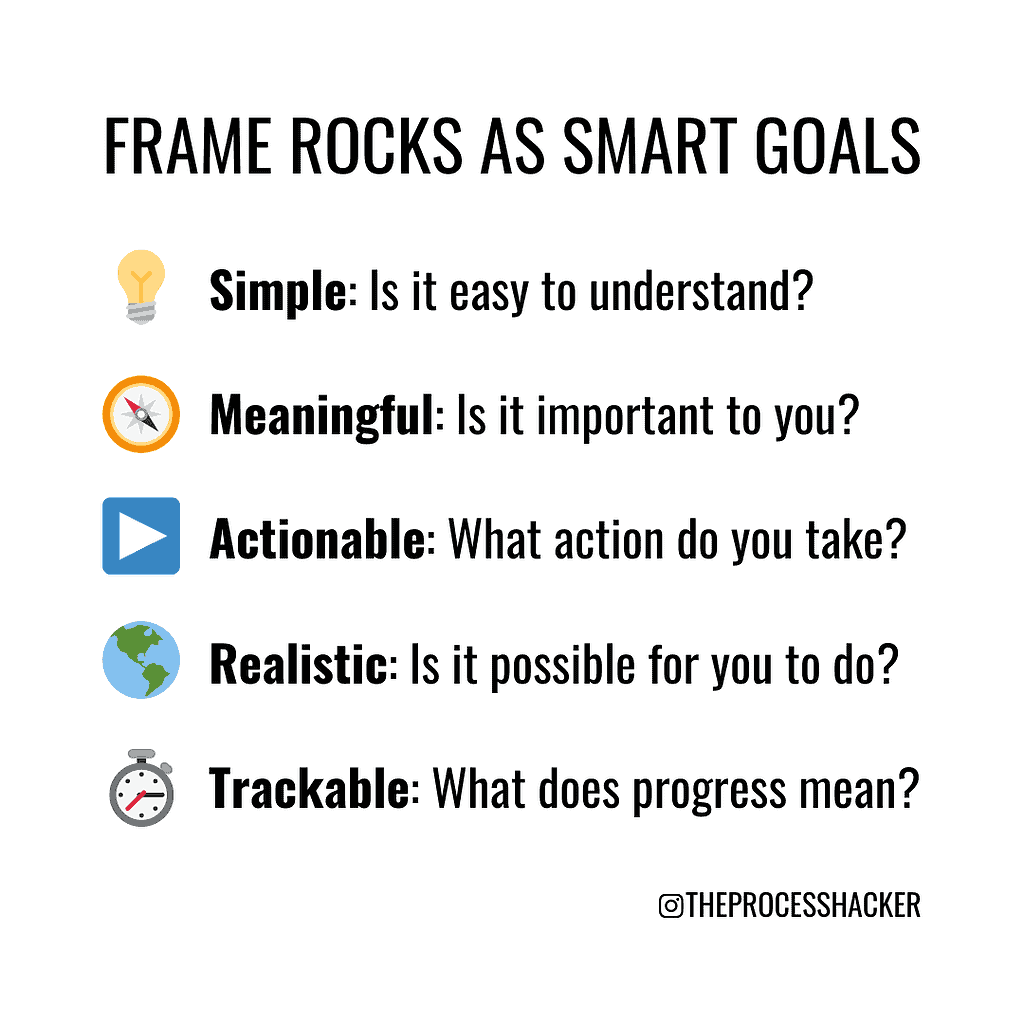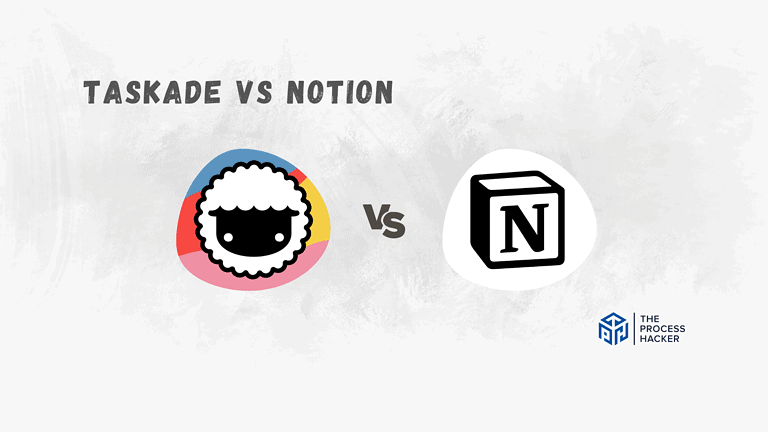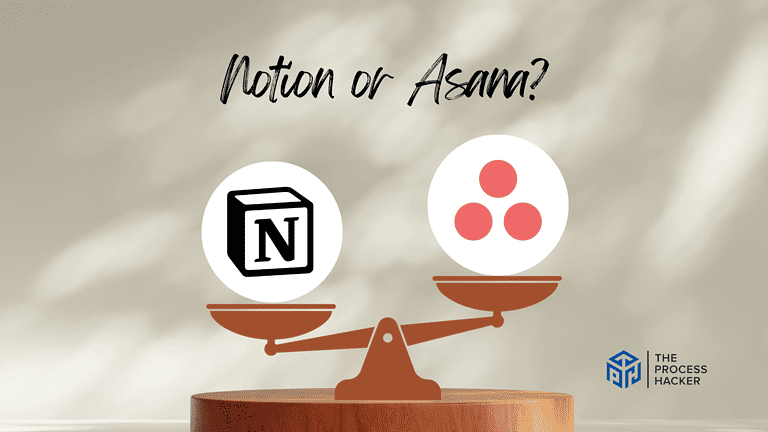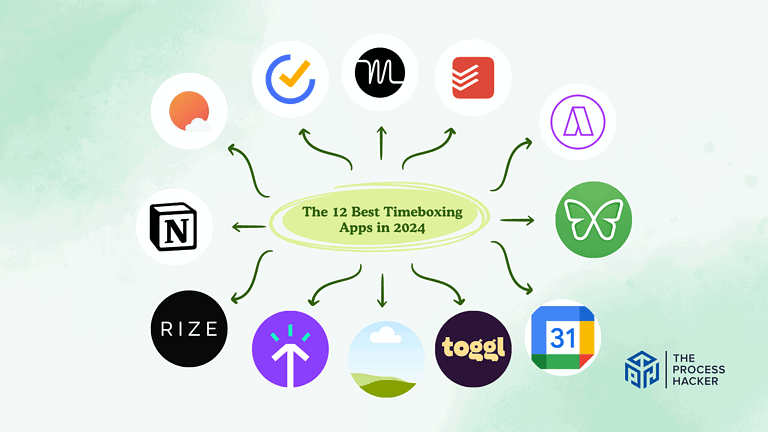Big Rocks: Setting Quarterly Goals for Business
“If the big rocks don’t go in first, they aren’t going to fit in later.”
Stephen Covey, author of The 7 Habits of Highly Effective People
Stephen Covey’s Big Rock theory or framework can help you establish quarterly goals for your business to be successful. Big rocks should be established at every level in an organization: company-wide, leadership, departmental, and personal.
Every employee needs to have goals to help them own to prioritize their work. When everyone is working on their big rocks, then the business gains traction toward achieving its vision.
Origin of the Big Rocks Concept

In the book, First Things First, Stephen Covey tells the Big Rocks story, in which the Big Rocks symbolize your most important priorities. First, he starts with the Eisenhower Matrix, which is a time management method for prioritizing important, long-term work over the unimportant, urgent stuff.
You need to determine the few important priorities to progress on your most important goals and maintain a balanced life. He illustrates this concept using the big rocks first analogy to encourage individuals to “place the big rocks first.”
First, Stephen Covey tells us to imagine a glass jar on your desk in which the empty space represents the time you have to manage. Next to the jar, there are large rocks, little rocks (gravel), sand, and a glass of water. These items represent all the stuff that you have to get done:
- The big rocks represent your main priorities or longer-term goals.
- The little rocks represent your day-to-day responsibilities and shorter-term goals.
- The sand represents minor tasks that are not really that important.
- The water represents the unimportant distractions that prevent you from getting work done.
Suppose you started with the urgent, unimportant stuff and then tried to fit in the longer-term, essential priorities. First, you dump the water and let the distractions get to you. Next, you fill in the sand and try to work on the minor tasks. After, you somewhat squeeze in the gravel or the day-to-day work. By the time you get to the big rocks or your most important priorities, you can’t fit them into your day.
It gets progressively harder for managing and spending time in this order of importance. Thus, Stephen Covey says to start with the big rocks and then add the gravel, then your sand, and water, respectively. Then, all of the things will fit into all the spaces of the glass jar or your day. This story teaches us that we need to focus on the fewer, higher-level goals to get more done. If we get stuck in the details, then the significant priorities will not get worked on.
What are Big Rocks?

In business, big rocks are your three to seven more truly important priorities or goals to get done in the next quarter. Honestly, I recommend having no more than a handful or 7 big rocks, as many people tend to have too many priorities. Having too many bigrocks can result in serious negative consequences. Also, everyone and everything should have them.
The company should have company-wide priorities, which are codified in the vision. Each department should have Departmental Big Rocks, and quarter rocks examples include Big Rock Marketing or Big Rocks Project Management. And all of your people should have their own individual goals.
To get you and your people to focus on what is essential, the number of all the big rocks has to be limited. Thus, you need to restrict them to three to seven to focus and get more big rocks activity. For individual employees, they should be further limited to one to three to get them to focus on a few priorities more intensely.
Big rocks in your life examples may include your health, family, community, personal, and more. For more on setting big rocks as a new entrepreneur, check out the book, Entrepreneurial Leap (book summary) by Gino Wickman.
Setting SMART Goals

You should establish big rocks using the SMART Goals (Simple, Meaningful, Actionable, Realistic, and Trackable) framework to help provide clarity and set expectations to get work done. In Start Finishing, Charlie Gilkey states that we have to take our ideas and frame them as SMART goals, which is different than the typical SMART acronym:
- S – Simple: A Simple Rock helps you get moving immediately on what you want to accomplish. Do you know what you need to do to get started to work on the Rock?
- M – Meaningful: A Meaningful Rock provides you with purpose, importance, or value. Do you have a quick understanding of the importance of completing that Rock?
- A – Actionable: An Actionable Rock helps you take bold, consistent action. Do you know what actions you need to take to accomplish the Rock?
- R – Realistic: A Realistic Rock is something that one has the capacity to accomplish within a specific period. Can you achieve the Rock in 90 days with the resources you have available?
- T – Trackable: A Trackable Rock helps you monitor and determine whether you are done or not done. Also, trackable priorities have a quarterly deadline. Can you quantitatively measure the progress toward completing the Rock?
To learn more about Charlie Gilkey’s book, you can read our summary of Start Finishing.
When you fail to accomplish a big rock, it is most likely due to not using the SMART framework. Don’t get hard on yourself. Instead, figure out why you failed and what was missing from the SMART framework, get more organized at work, and restart the goal in a future quarter.
How to Set Big Rocks within Your Organization

- Review your corporate vision, and list out everything you want to accomplish in the next quarter. Do not filter yourself, as this will result in about 10 to 20 goals in total.
- Discuss within the leadership team or departmental levels, which big rocks are the most important to work on in the next quarter. Next, you and your team have to combine, eliminate, delay, or decide as necessary to narrow the list down to three to seven.
- Frame the objectives as SMART (Simple, Meaningful, Actionable, Realistic, and Trackable) goals. Each one should have assigned due dates, which will probably occur at the end of 90 days.
- Assign each big rocka to an individual within the team. This individual will be responsible for completion by the end of the quarter and should be held accountable by the rest of the team.
- Create a document containing the goals for the company and each department. This sheet should be made accessible to everyone to help create accountability and discipline within your teams.
- Hold a company-wide quarterly meeting for the leadership team to communicate the big rocks to everyone. This will provide transparency to everyone as to what was accomplished last quarter and where the company is going in the coming quarters.
- Now that goals have been assigned for the company as a whole and each department, everyone should set their one to three most important priorities for the quarter. For the company to gain traction toward the vision, everyone in the organization needs to have big rocks.
- Hold your people accountable for their goals during weekly meetings. The meeting pulse involves holding reoccurring meetings to gain traction. These meetings provoke your people to take action on their priorities as most people tend to procrastinate on work.
Rules of Thumb for Big Rocks

- Setting the wrong goals will move the company in the wrong direction. Going in the wrong direction is a waste of your precious resources, precisely time and money. Thus, it is essential to take the time to establish SMART goals to gain traction on the priorities.
- It takes about a few quarters to become proficient in setting great goals. With anything that you get good at, you need to practice and gain experience. Thus, the art of establishing priorities is something that comes better with action over time.
- Commit purposefully to accomplishing your big rocks. You want to invest so strongly, such that you take consistent 10X action on your priorities for the entire quarter. If you don’t commit, you may lose motivation and may give up easily.
- Don’t set too many big rocks as less is more. We overestimate what we can accomplish in a quarter and underestimate what we can do in 10 years. Fewer priorities will help you focus and finish instead of becoming overwhelmed and losing motivation.’
Each quarter is an opportunity to do a slight reset and establish new goals for you, your company, and your people. Big rocks are powerful tools to gain traction on the corporate vision and move forward. Your people will be more engaged with their priorities, be held accountable, and get more done in the process.
Example: Big Rocks for Sales
Here are some big rocks or wildly important goal examples for sales:
- Growing your market share by targeting a new niche or segment of your audience.
- Expanding into a new region or country in order to reach potential customers who would otherwise be inaccessible.
- Increasing the number of recurring sales you generate from each customer, by offering additional products or services that complement your existing offerings.
- Increasing sales and conversions through the use of targeted marketing campaigns and promotions.
- Attracting more customers to your business by delivering exceptional customer service, whether via phone or online chat.
- Improving your website’s search engine rankings so that potential customers can more easily find you online.
- Increasing your customer satisfaction levels so that they remain loyal to your business year after year.
Whatever your big rocks may be, the key to achieving it is to stay focused and motivated at all times!
Next Steps
I hope this post helps you set Big Rocks for you, your company, and/or your people. You can read more about Stephen Covey’s Big Rocks concept in the book, First Things First or watch this Big Rocks video.
For more on create a 12-week plan for your big rocks, check out The 12 Week Year (book summary). For more on gaining traction on the vision, check out the book, Traction: Get a Grip on Your Business (pdf book summary) by Gino Wickman.







